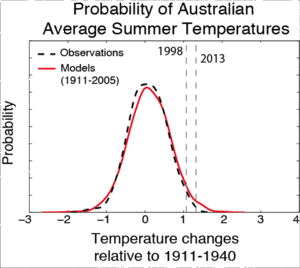This article is more than 1 year old
Oz's 2013 heatwave was man made
Dancing on the edge of the bell curve
It was a summer notable both for long heatwaves and for extremes that led the Bureau of Meteorology to update its heat map colour schemes to take into account a new normal. Now, University of Melbourne scientists believe they can attribute the unusual heat of summer 2012-2013 to human-driven climate change.
The university's researchers, Dr Sophie Lewis and professor David Karoly, working with the ARC Centre of Excellence for Climate System Science, ran 100 years' worth of observations against more than 90 climate model simulations.
The researchers also ran climate model runs to compare human and natural influences in parallel experiments, and these suggested Australia “experienced a very unusual summer at a time when it was not expected”.
“This extreme summer is not only remarkable for its record-breaking nature but also because it occurred at a time of weak La Niña to neutral conditions, which generally produce cooler summers,” Karoly says in the ARC CE CSS announcement.
“Importantly, our research shows the natural variability of El Niño Southern Oscillation is unlikely to explain the recent record temperatures.”

The chance of extreme temperatures is rising
Source: ARC CECSS
The researchers put a 90 percent confidence level on their analysis, and added that we'd better get used to it: the chance of similar events is five times higher than prior to the onset of climate change.
They also state that their analysis is one of the fastest ever conducted, thanks to the supercomputers of the National Computing Infrastructure (not the new Raijin machine, however, since that only went live last week).
The researchers also collaborated with CSIRO and the Bureau of Meteorology.
The study is published in Geophysical Research Letters (abstract here). ®
